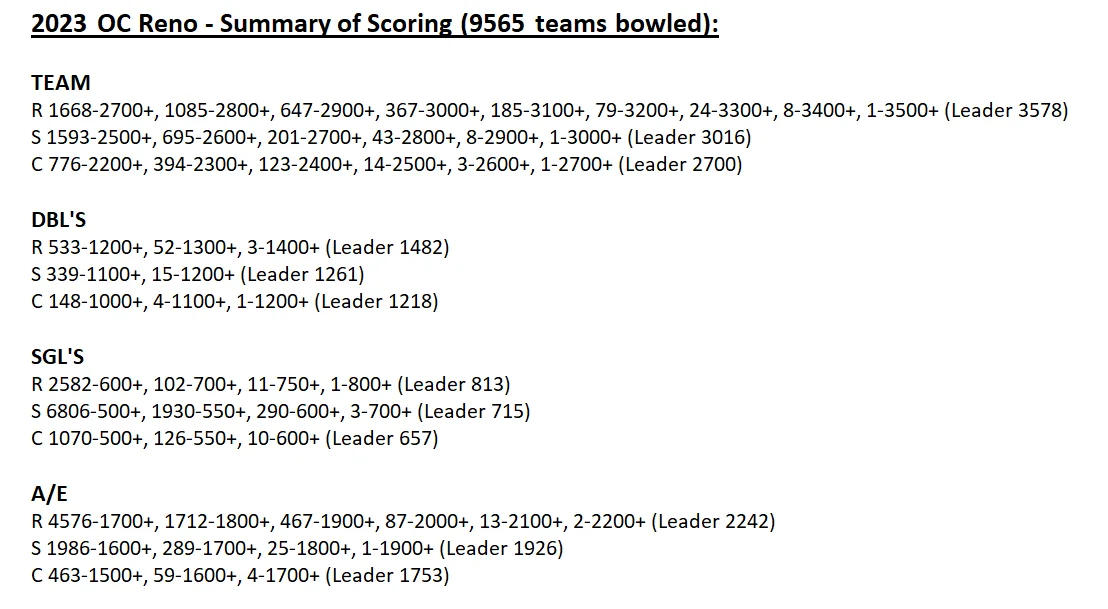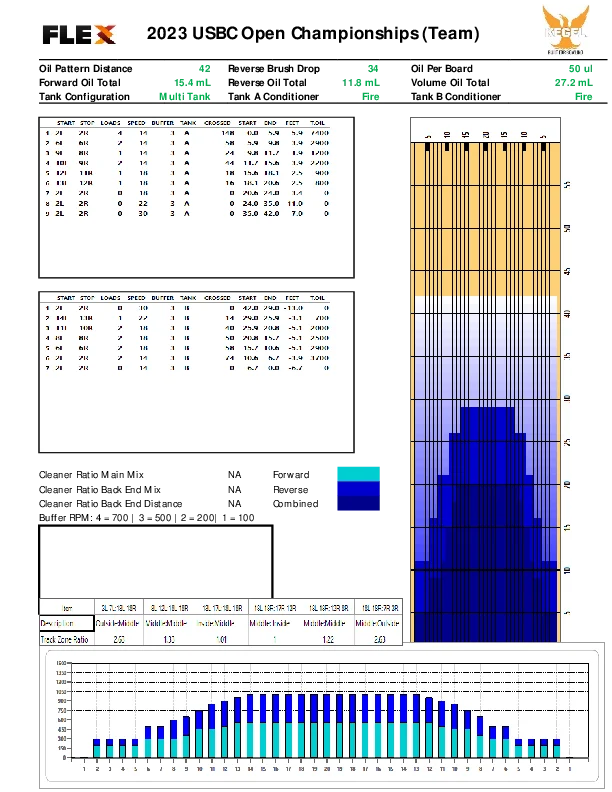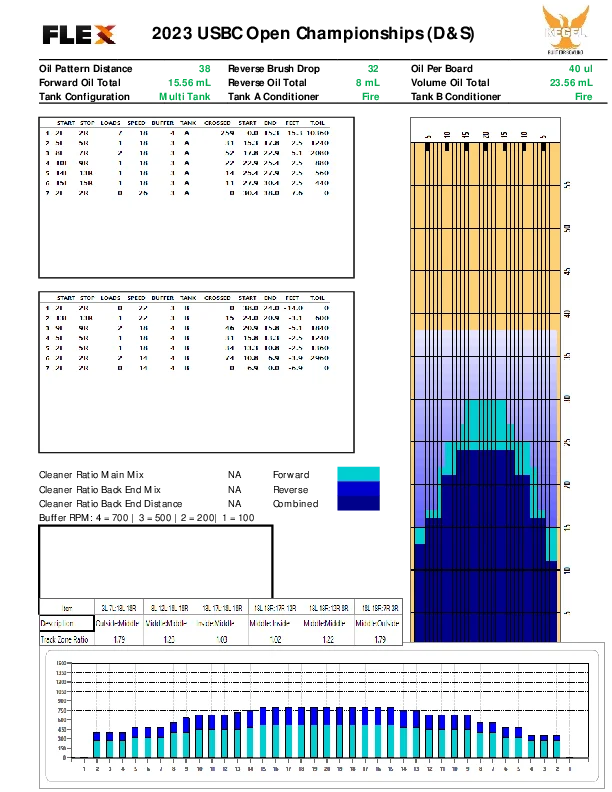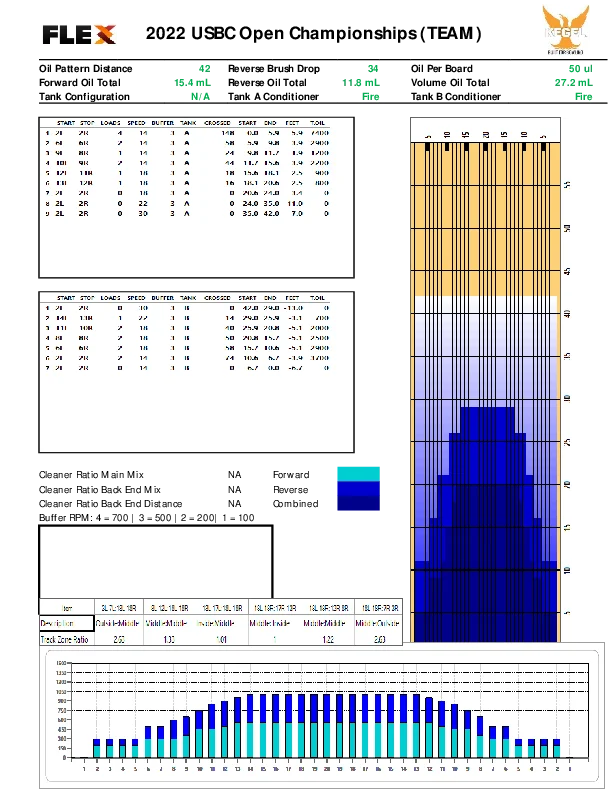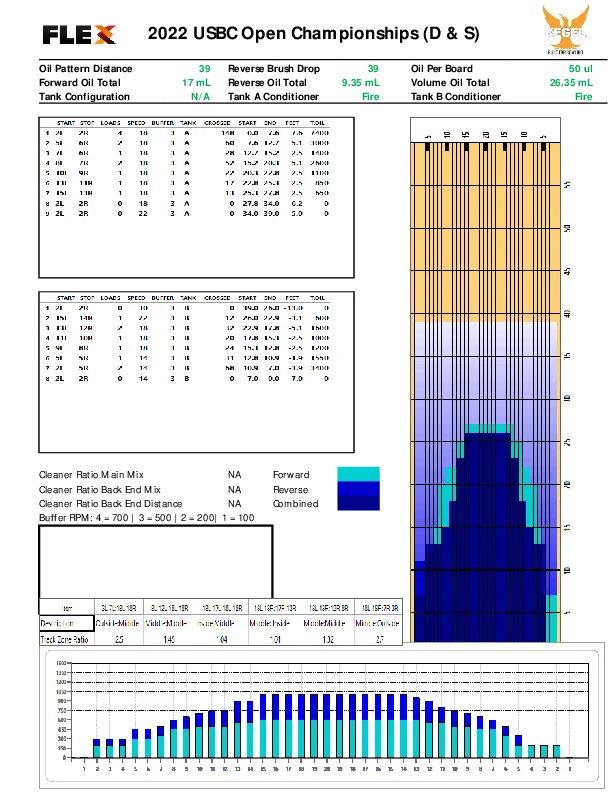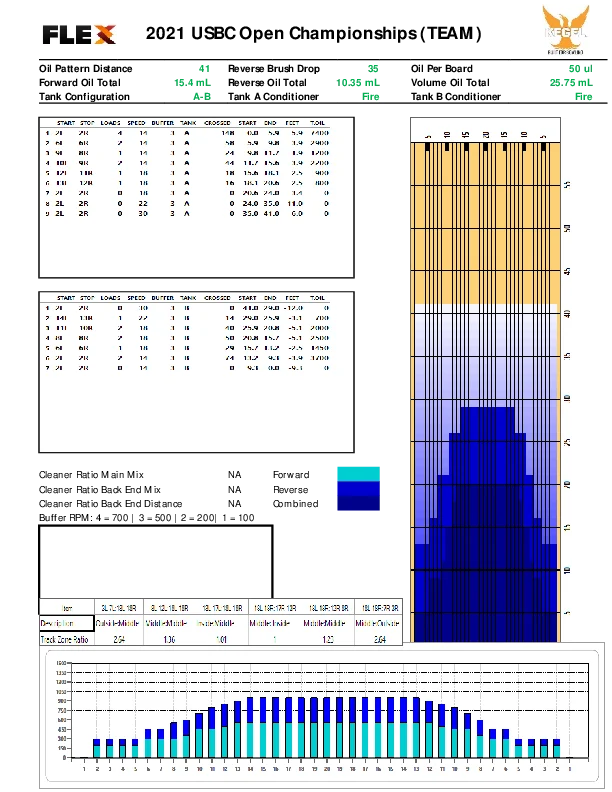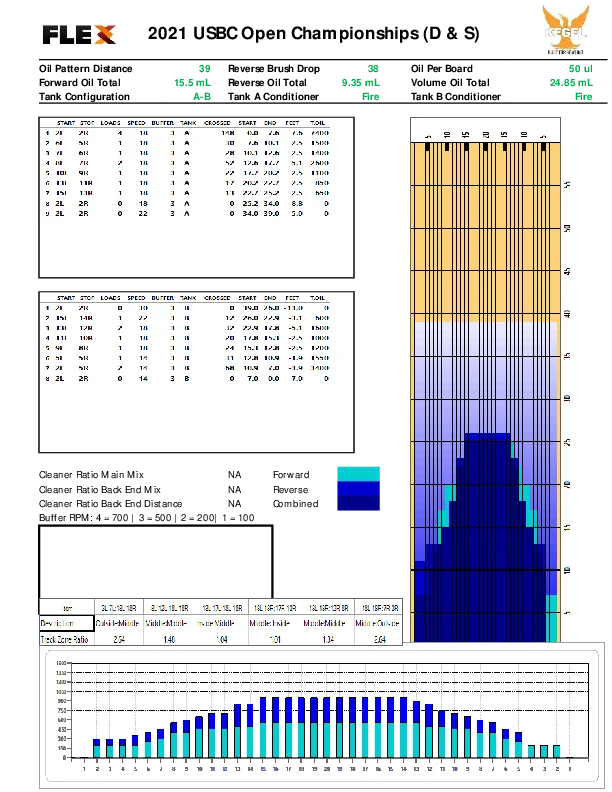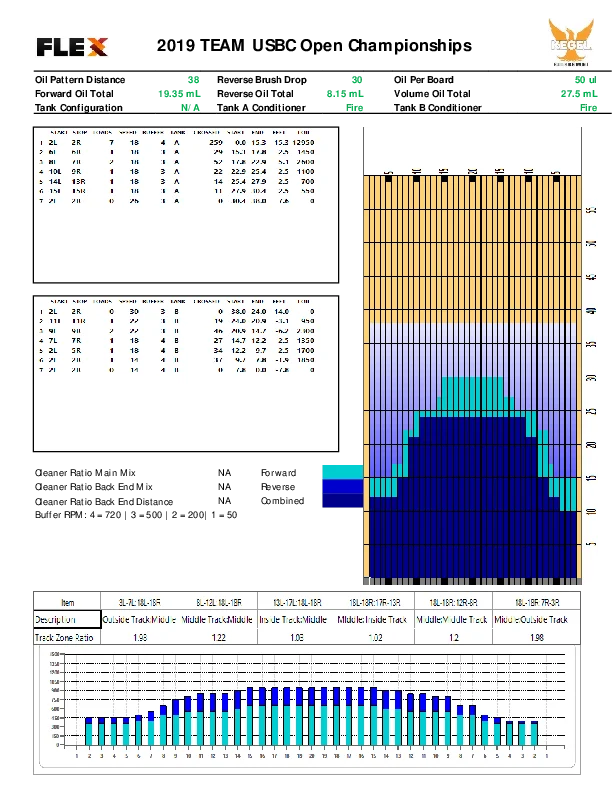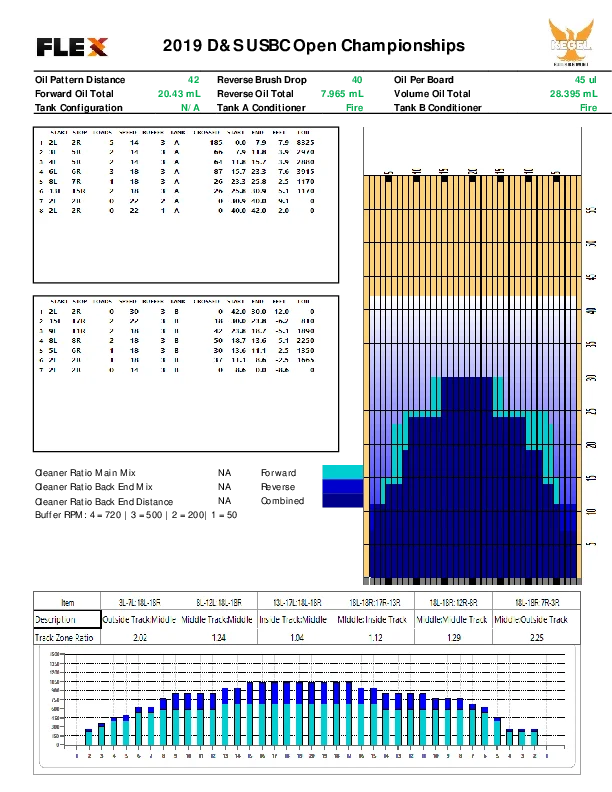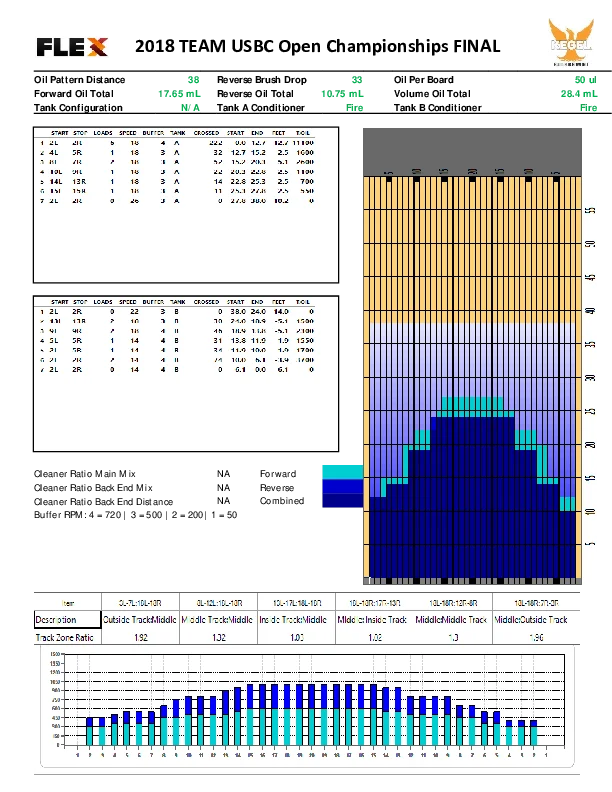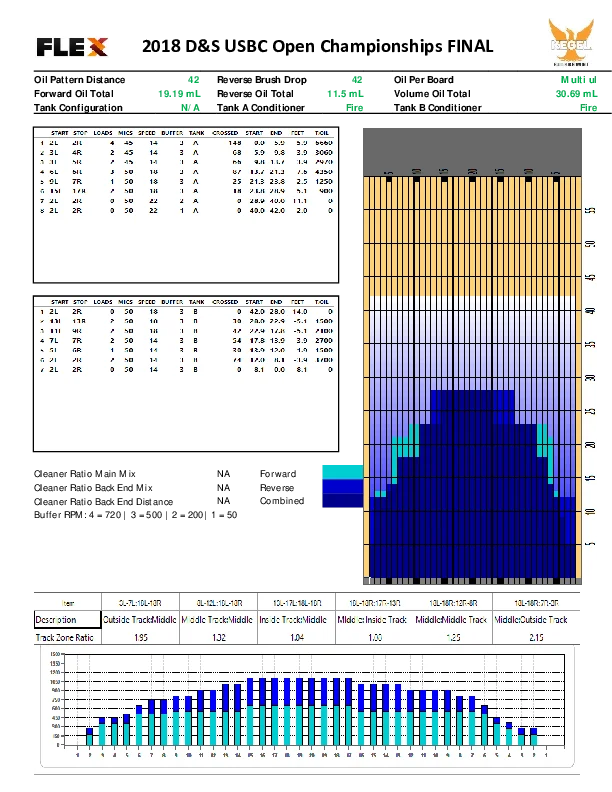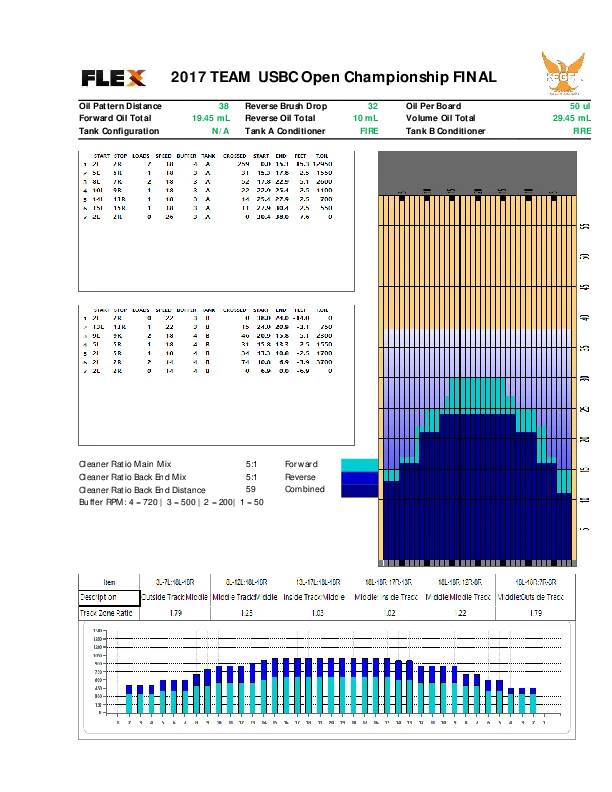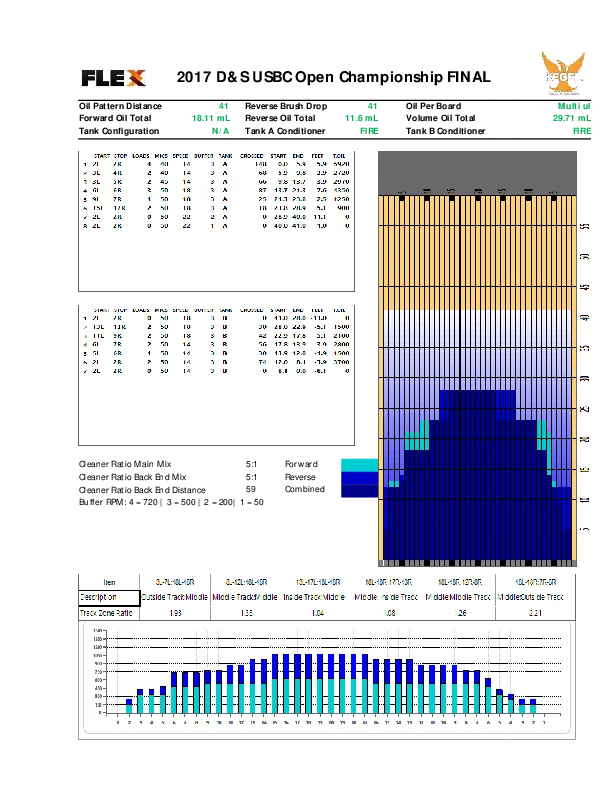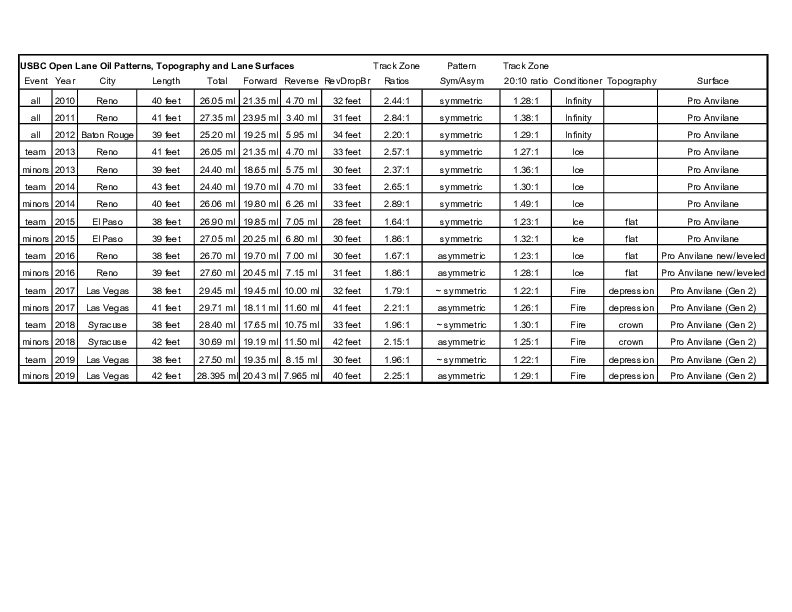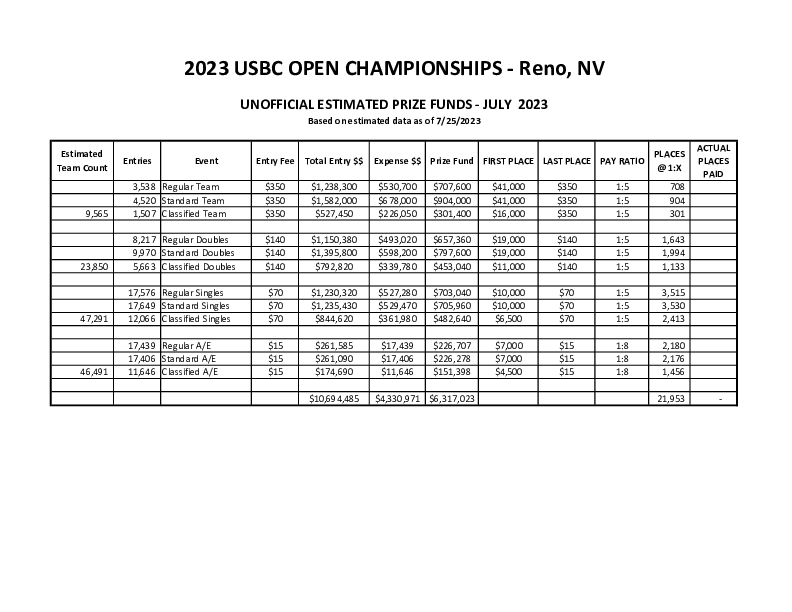Bowling's digital daily newspaper delivering news, analysis and opinion.
2023 USBC Open Championships shows the competitive evil of hiding lane patterns in an extended tournament

If you don’t understand the competitive evil of hiding lane patterns in a tournament where all competitors don't bowl at the same time, you just don’t understand.
The 2023 USBC Open Championships might be the best illustration yet of why hiding the patterns is so competitively unfair.
By the time the tournament was a couple weeks in, it was obvious that the minors pattern was hooking an abnormal amount. (The team pattern clearly was close to last year and turned out to be a repeat of the 2022 team pattern.)
By the time Kyle Luckett took the singles lead on May 7 (a day after we bowled minors), the idea of urethane as THE way to attack the minors pattern was becoming a topic. And after Nick Kruml and crew destroyed the minors pattern with urethane and then resin on June 3 it was obvious that starting with urethane (and sticking with it if you could) was best.
You have to wonder if Mark Curtis Jr. and DeeRonn Booker would have started with and stayed with urethane as they started with 381 the first game and then blew up to 1,482 and the doubles Eagle on Saturday.
I know I would have had a Storm PITCH BLACK in my bag and used it to start minors if we had bowled after Kruml’s group, and also would have brought a real weak reactive resin — not that it probably would have made a huge difference at my age with my revs.
But there certainly were younger and more competitive bowlers who might have made better decisions if they had known this year’s minors pattern had the lowest volume since 2007 at 23.56 mL — all the patterns and numbers are attached to this story or in this story.
One very knowledgeable and skilled veteran bowler sent me this private message that summed it up well:
“After seeing the actual patterns now I was pretty close with my guess for both after we bowled on them. If ever there is proof of why the patterns should be published prior to the tournament, the minors pattern this year should be an eye opener. The scores on that pattern started out very low, but by the end of the tournament the scoring level was exponentially higher. Bowlers gained enough information that it became obvious to many that they could utilize urethane and play the outside angle to produce higher scores in doubles, and once that option started to go away they just moved left three or four zones with reactive balls and didn't miss a beat. Of course, not everyone can use urethane to their advantage, but I could have used a weaker reactive and played more direct from outside. However, I didn't have anything that weak with me because it has been years since I needed that option. The overall scoring level in minors remained lower because a good majority of the bowlers were unable to play anywhere between 7 and 15 where they are most comfortable.”
My post of the patterns on Facebook created a predictably spirited and lengthy thread of comments that covered much more than hiding the patterns.
I pointed out that “All a 23 mL pattern does is benefit higher rev and speed players and urethane tossers. Your moderate and slow ball speed player with typical equipment was in a bad spot. Remember the AVERAGE AGE of a USBC OC competitor is over 50.”
Mark Taylor, who designs patterns for the youth tournaments he runs in the northeastern U.S., noted that “Some players possess excellent physical games that allow them to overcome shortfalls in their mental and/or knowledge games. That is essentially independent of the pattern choice. Conversely, good and/or older players who no longer possess their younger physical gifts are able to close some/all of the gap my using their minds to make good decisions because that’s their strength (raising my hand). However, the lack of pattern disclosure and transparency neuters their strengths before they even pack their bags and get on the plane because it’s more a guess of equipment choices/surface prep than allowing them to use their best skill they’ve developed over time.”
Anthony Schnack made it simple: “I definitely would have had urethane if I bowled later in the event. We bowled in mid April and didn't see too much urethane being thrown effectively in the first month of the event to make a decision to bring it with.”
While Eagle winner Jerry Kessler voiced support for the low volume, PBA Tour champion made a point he and Chris Barnes have made on their Beef and Barnzy show: “The lanes surfaces have changed, the balls have changed, the players styles have changed. The only thing not changing is the lane guys and the amount of oil they put on the lane… also no allowance for the fact they keep going flatter, therefore even less actual oil in the usable part of the lanes. This is like everyone driving a truck and making roads just wide enough for a mini cooper. I will never understand why they keep doing this.”
David O'Sullivan added that “with today’s equipment, that wasn’t enough volume for the average bowler. I agree with Stu, we should be bowling on more volume today than we do. Synthetic panels are 35+ years old, balls keep getting stronger, something’s gotta give.”
The 2023 team pattern was 42 feet featuring a 34-foot drop brush and 27.2 mL of Kegel Fire oil divided at 15.4 mL forward and 11.8 mL reverse. It was asymmetrical with left side ratios of 2.63-1 middle-outside track, 1.33-1 middle-middle track and 1.01-1 middle-inside track and right-side ratios of 2.63-1 middle-outside track, 1.22-1 middle-middle track and 1-1 middle-inside track.
The 2023 minors pattern was 38 feet with a 32-foot drop brush and 23.56 mL of Kegel Fire oil divided at 15.56 mL forward and 8 mL reverse. It was a tad asymmetrical with left side ratios of 1.79-1 middle-outside track, 1.23-1 middle-middle track and 1.03-1 middle-inside track and right-side ratios of 1.79-1 middle-outside track, 1.22-1 middle-middle track and 1.02-1 middle-inside track.
The 2022 team pattern was 42 feet featuring a 34-foot drop brush and 27.2 mL of Kegel Fire oil divided at 15.4 mL forward and 11.8 mL reverse. It was asymmetrical with left side ratios of 2.63-1 middle-outside track, 1.33-1 middle-middle track and 1.01-1 middle-inside track and right-side ratios of 2.63-1 middle-outside track, 1.22-1 middle-middle track and 1-1 middle-inside track.
The 2022 minors pattern was 39 feet with a 39-foot drop brush and 26.35 mL of Kegel Fire oil divided at 17 mL forward and 9.35 mL reverse. It was asymmetrical with left side ratios of 2.5-1 middle-outside track, 1.45-1 middle-middle track and 1.04-1 middle-inside track and right-side ratios of 2.7-1 middle-outside track, 1.32-1 middle-middle track and 1.01-1 middle-inside track.
The 2021 team pattern was 41 feet featuring a 35-foot drop brush and 25.75 mL of Kegel Fire oil divided at 15.4 mL forward and 10.35 mL reverse. It was asymmetrical with left side ratios of 2.64-1 middle-outside track, 1.36-1 middle-middle track and 1.01-1 middle-inside track and right-side ratios of 2.64-1 middle-outside track, 1.23-1 middle-middle track and 1-1 middle-inside track.
The 2021 minors pattern was 39 feet with a 38-foot drop brush and 24.85 mL of Kegel Fire oil divided at 15.5 mL forward and 9.35 mL reverse. It was asymmetrical with left side ratios of 2.64-1 middle-outside track, 1.48-1 middle-middle track and 1.04-1 middle-inside track and right-side ratios of 2.64-1 middle-outside track, 1.23-1 middle-middle track and 1-1 middle-inside track.
There was no tournament in 2020 due to the COVID-19 pandemic.
The 2019 team pattern was 38 feet featuring a 30-foot drop brush and 27.5 mL of Kegel Fire oil divided at 19.35 mL forward and 8.15 mL reverse. It was effectively symmetrical with left side ratios of 1.98-1 middle-outside track, 1.22-1 middle-middle track and 1.03-1 middle-inside track and right-side ratios of 1.98-1 middle-outside track, 1.2-1 middle-middle track and 1.02-1 middle-inside track.
The 2019 minors pattern was 42 feet with a 40-foot drop brush and 28.395 mL of Kegel Fire oil divided at 20.43 mL forward and 7.965 mL reverse. It was asymmetrical with left side ratios of 2.02-1 middle-outside track, 1.24-1 middle-middle track and 1.04-1 middle-inside track and right-side ratios of 2.25-1 middle-outside track, 1.29-1 middle-middle track and 1.12-1 middle-inside track.
The 2018 team pattern was 38 feet featuring a 33-foot drop brush and 28.4 mL of Kegel Fire oil divided at 17.65 mL forward and 10.75 mL reverse. It was effectively symmetrical with left side ratios of 1.92-1 middle-outside track, 1.32-1 middle-middle track and 1.03-1 middle-inside track and right-side ratios of 1.96-1 middle-outside track, 1.3-1 middle-middle track and 1.02-1 middle-inside track.
The 2018 minors pattern was 42 feet with a 42-foot drop brush and 30.69 mL of Kegel Fire oil divided at 19.19 mL forward and 11.5 mL reverse. It was asymmetrical with left side ratios of 1.95-1 middle-outside track, 1.32-1 middle-middle track and 1.04-1 middle-inside track and right-side ratios of 2.15-1 middle-outside track, 1.25-1 middle-middle track and 1.08-1 middle-inside track.
The 2017 team pattern was 38 feet featuring a 32-foot drop brush and 29.45 mL of Kegel Fire oil divided at 19.45 mL forward and 10 mL reverse. It was effectively symmetrical with left side ratios of 1.79-1 middle-outside track, 1.23-1 middle-middle track and 1.03-1 middle-inside track and right-side ratios of 1.79-1 middle-outside track, 1.22-1 middle-middle track and 1.02-1 middle-inside track.
The 2017 minors pattern was 41 feet with no drop brush and 29.71 mL of Kegel Fire oil divided at 18.11 mL forward and 11.6 mL reverse. It was asymmetrical with left side ratios of 1.93-1 middle-outside track, 1.33-1 middle-middle track and 1.04-1 middle-inside track and right-side ratios of 2.21-1 middle-outside track, 1.26-1 middle-middle track and 1.08-1 middle-inside track.
PDFs of the patterns from 2017 to 2023 are attached to the bottom of this story.
PDFs of the patterns from 2016 back to the turn of the century as they are available are in this story.
For historical perspective, the records are DiLaura Brothers 10,585 in team all-events in 2022, Artistic Expressions No. 1 3,720 in team in 2014, Stephen and Brenda Padilla 1,566 in doubles in 2009, Bo Goergen 862 in singles in 2009, and Matt McNiel 2,326 in all-events in 2010.
Below is my updated score comparison for the Open Championships back to 2000 with the 2023 numbers for first, 50th, 100th and 150th team, singles and all-events, and first, 25th, 50th and 75th for doubles. Results are available at the tournament leaderboards. (There are no extended standings for team all-events.)
Digging down past the winning scores provides more accurate comparisons because it takes away the outlier of a big winning score. This year’s team event is a perfect example, with 3,578 being the second-highest winning score ever, but 50th, 100th, and 150th not being all that high.
TEAM (1st-50th-100th-150th)
2023 (3578-3245-3168-3125)
2022 (3486-3275-3223-3180)
2021 (3400-3204-3132-3082)
2019 (3362-3110-3043-3000)
2018 (3322-3080-3022-2981)
2017 (3266-3078-3022-2978)
2016 (3377-3102-3039-2991)
2015 (3368-3076-3004-2970)
2014 (3720-3323-3267-3215)
2013 (3538-3326-3248-3207)
2012 (3401-3129-3046-3001)
2011 (3473-3257-3199-3153)
2010 (3408-3177-3105-3062)
2009 (3449-3136-3086-3040)
2008 (3374-3142-3078-3035)
2007 (3405-3141-3081-3032)
2006 (3496-3241-3149-3101)
2005 (3302-3020-2977-2945)
(1st-50th-100th)
2004 (3268-3022-2963)
2003 (3294-3052-2988)
2002 (3473-3185-3122)
2001 (3273-3086-3036)
2000 (3513-3194-3137)
DOUBLES (1st-25th-50th-75th)
2023 (1482-1327-1300-1288)
2022 (1522-1419-1389-1373)
2021 (1466-1378-1342-1326)
2019 (1478-1352-1321-1302)
2018 (1457-1373-1337-1320)
2017 (1478-1348-1331-1309)
2016 (1401-1325-1295-1282)
2015 (1409-1331-1309-1290)
2014 (1465-1375-1353-1341)
2013 (1440-1362-1338-1320)
2012 (1489-1386-1358-1338)
2011 (1497-1426-1406-1384)
2010 (1514-1413-1380-1366)
2009 (1566-1401-1377-1360)
2008 (1467-1393-1368-1357)
2007 (1544-1388-1365-1355)
2006 (1497-1388-1371-1360)
2005 (1500-1355-1341-1327)
2004 (1477-1358-1332-1319)
2003 (1540-1374-1354-1339)
2002 (1534-1403-1371-1360)
2001 (1449-1343-1328-1316)
2000 (1534-1406-1378-1360)
SINGLES (1st-50th-100th-150th)
2023 (813-718-700-693)
2022 (848-761-751-734)
2021 (802-739-721-709)
2019 (812-739-725-713)
2018 (802-734-718-708)
2017 (804-735-716-706)
2016 (815-730-712-703)
2015 (793-724-710-699)
2014 (826-758-742-72x)
2013 (795-743-730-721)
2012 (800-728-716-707)
2011 (826-758-745-737)
2010 (833-747-732-723)
2009 (862-752-738-728)
2008 (832-744-727-718)
2007 (814-746-733-725)
2006 (812-745-729-720)
2005 (791-728-715-706)
(1st-50th-100th)
2004 (858-735-719)
2003 (837-742-726)
2002 (823-754-737)
2001 (798-728-714)
2000 (811-753-742)
ALL-EVENTS (1st-50th-100th-150th)
2023 (2242-2026-1993-1971)
2022 (2241-2125-2083-2059)
2021 (2303-2077-2028-2003)
2019 (2156-2027-1990-1972)
2018 (2186-2031-1993-1971)
2017 (2176-2022-1985-1956)
2016 (2133-1999-1972-1951)
2015 (2226-2008-1973-1947)
2014 (2273-2107-2076-2060)
2013 (2228-2089-2051-2034)
2012 (2202-2034-1995-1977)
2011 (2268-2117-2081-2059)
2010 (2326-2079-2041-2018)
2009 (2321-2079-2039-2016)
2008 (2183-2052-2023-2004)
2007 (2198-2065-2033-2011)
2006 (2189-2083-2041-2022)
2005 (2131-2000-1970-1950)
(1st-50th-100th)
2004 (2224-1996-1970)
2003 (2215-2042-2000)
2002 (2279-2096-2060)
2001 (2219-2016-1984)
2000 (2181-2085-2051)
If you want more details, Open Championships scores going back to 2005 can be found here.
If you want to try to view 2000-2004 results, click this archive link, then in the search field type "abctournament.com" A calendar will display with banner of years and then click one of those years in the banner and it will update the calendar and just click a highlighted "circle" date after close of the tourney, suggest mid-July or later, and it will redirect you to that old webpage of tourney info and results. Go back to Calendar and click other years and do same for those results.
I am not guaranteeing this will work for all users!
The Open Championships historical page that includes all champions, records, etc. is here.
